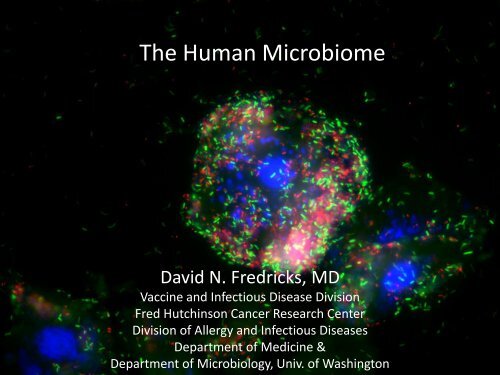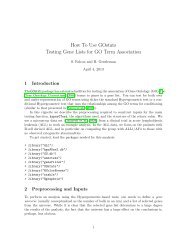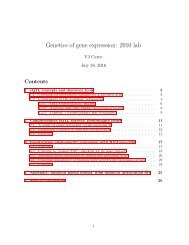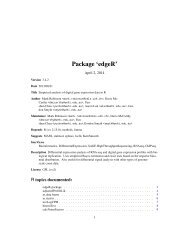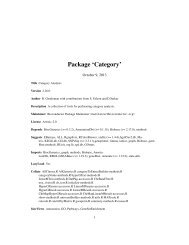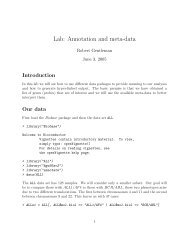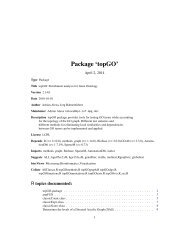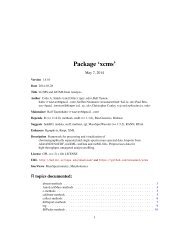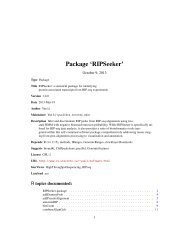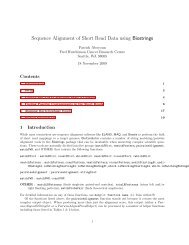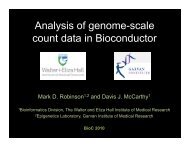The Human Microbiome - Bioconductor
The Human Microbiome - Bioconductor
The Human Microbiome - Bioconductor
- No tags were found...
You also want an ePaper? Increase the reach of your titles
YUMPU automatically turns print PDFs into web optimized ePapers that Google loves.
<strong>The</strong> <strong>Human</strong> <strong>Microbiome</strong>David N. Fredricks, MDVaccine and Infectious Disease DivisionFred Hutchinson Cancer Research CenterDivision of Allergy and Infectious DiseasesDepartment of Medicine &Department of Microbiology, Univ. of Washington
Outline• Role of the indigenous microbiota in human health and disease– <strong>The</strong> human microbiota and microbiome: definitions• Introduction to molecular methods for characterizing themicrobial inhabitants of humans• <strong>The</strong> human vaginal microbiota– Diversity: What is the bacterial census of the human vagina?• Species richness, composition, and concentration– Dynamism: how stable are vaginal bacterial communities and whatfactors influence the composition and concentrations of bacteria?– Dysbiosis: What changes ensue with the onset of bacterial vaginosis (BV)and what is the impact of antibiotic treatment for BV?• Use of “omics” approaches to characterize the genetic andfunctional capabilities of microbial communities• Single cell genomics and metagenomics (genes)• Metatranscriptomics (mRNA and rRNA)• Proteomics and metabolomics (proteins and metabolites)
<strong>Human</strong> Genome Project (HGP)• 3.16 billion base pairs of DNA in genome; cost of HGP: $2.7 billion• Anticipated number of human genes at initiation of project: >100,000– Fruit fly ~ 14,000 genes, Chicken ~23,000 genes, Corn ~59,000 genes• <strong>Human</strong>s ~25,000 genes!
<strong>Human</strong>s as “Super-organisms”<strong>Human</strong>: 10 13 human cells<strong>Human</strong>: 10 14 bacterial cells• <strong>The</strong> microorganisms that live on and inside humans (themicrobiota) are estimated to outnumber human somatic andgerm cells by a factor of ten• Together, the genomes of these microbial symbionts providetraits that humans did not need to evolve on their own– <strong>Microbiome</strong> #1: collection of microbial genes associated with humans– <strong>Microbiome</strong> #2: collection of microbes within the human biome• We are a genetic and metabolic composite of microbial andhuman cells, leading to the concept of the human superorganism– More than 3,000,000 genes provided by our gut microbiome!
<strong>The</strong> <strong>Human</strong> <strong>Microbiome</strong> Project Peter J. Turnbaugh, Ruth E. Ley, Micah Hamady,Claire M. Fraser-Liggett, Rob Knight & Jeffrey I. GordonNature 449, 804-810(18 October 2007HMP Goals:1. Determining whetherindividuals share a corehuman microbiome2. Understanding whetherchanges in the humanmicrobiome can becorrelated with changes inhuman health<strong>The</strong> core human microbiome (red) is the set of genes present in a givenhabitat in all or the vast majority of humans. Habitat can be defined over arange of scales, from the entire body to a specific surface area, such asthe gut or a region within the gut. <strong>The</strong> variable human microbiome (blue) isthe set of genes present in a given habitat in a smaller subset of humans.
Cultivation vs. Molecular Analyses of the<strong>Human</strong> <strong>Microbiome</strong>• Cultivation of microbes– Description of species (phenotypic or genotypic)– Sequence genomes from isolates• Cultivation-independent analysis of microbialpopulations and their genes (molecular)– PCR of 16S rRNA genes from bacteria to detect andidentify species; no information on other elements of themicrobiome– Metagenomic analysis: extract nucleic acid directly from asample and perform high throughput sequencing tocatalog the microbes and genes representedDNA
Science. 2006 Jun 2;312(5778):1355-9.<strong>The</strong> <strong>Human</strong> Gut <strong>Microbiome</strong>
• 3.3 million non-redundant microbial genes• >1000 gut bacterial species in cohort of 124– But only ~160 bacterial species/individual• About 500,000 microbial genes/individual– 40% of genes present in at least half of cohort
<strong>The</strong> gut microbiome affects…• Vitamin production (vitamin K)• Development of innate and adaptive immunity• Turnover of gut epithelial cells (malignancy?)• Metabolism of xenobiotics (drugs)• Harvest of nutrients/energy metabolism(physiology)– Propensity to develop obesity• Organ size: Heart, intestine– Anatomy and development• Locomotor activity (behavior)Nature 449, 804-810(18 October 2007)
<strong>The</strong> 16S rRNA gene• Present in all bacteria (essential: codes for small subunit ofribosomal RNA complex, necessary for protein synthesis)• Has properties of a molecular clock– rDNA sequence similarities between species correlate withevolutionary relatedness (time to common ancestor)– Little evidence of horizontal gene transfer or recombination• Conserved regions: useful for broad range PCR• Variable regions: useful for species identificationwww.bioinformatics-toolkit.org
<strong>The</strong> bacterial 16S rRNA genePresent in all bacteriaVariableLittle evidence ofhorizontal gene transferAccurate phylogeniesConserved
Why Study the Vaginal Microbiota?• <strong>The</strong> vaginal microbiota affects the health of womenand impacts the success of pregnancy– E. coli colonization of the vagina may precede UTI– Group B streptococcus and neonatal sepsis• <strong>The</strong> vagina hosts unique consortia of microbessuggesting selection for these key organisms• Bacterial vaginosis (BV) is a condition linked tonumerous health problems, including: Preterm birth Pelvic inflammatory disease (infection of upper tract) HIV acquisition and shedding Increased risk of other sexually transmitted diseases (GC, CT, Trich, HSV, HPV) Post hysterectomy vaginal cuff cellulitis and other surgical infectionsEpidemiology. 2007;18:702-8.Sobel JD. Infect Dis Clin N Am 2005;19:387-406
Bacterial Vaginosis<strong>The</strong> most prevalent cause of vaginal symptomsamong women of childbearing age~ 4 million doctor visits/year in U.S. >10% of women experience BV NHANES survey in US: overall prevalence 29% Prevalence >50% in settings with high HIV burden (SS Africa)‣ Abnormal vaginal discharge in ~50% of women Increased amount -glycosidase activity of GNR on vaginal mucous Odor from volatilization of amines produced by anaerobicmetabolism trimethylamine‣ High rate of relapse: causes unknown
Bacterial Vaginosis (BV)Gram stain of normal vaginal fluid withmany GPR (lactobacilli), normal epithelialcellsGram stain of BV with few GPR,greater diversity of morphotypes,and clue cells
Schematic for Pyrosequencing Approach16S rRNA GeneFusion primer A: broad range Fw primerFusion primer B: Bar code: Broad range RevBroad-range PCRAlignment /Data AnalysisSequencing bysynthesisPCR Productsw/ Fusion PrimersemPCRAttachment to BeadBeads to Picotiter Plate
Pyrosequencing PipelineRemove Roche PrimersBin based on barcodesDatabase – curated reference sequencesfrom Fredricks LabRemove barcodes & LinkersDetermine if sequence originatesfrom gene-specific primersAlignment & placement onreference treeRank Abundance PlotsPhylogenetic TreesDiversity indicesTaxonomic assignment using treetopologyIf no match with reference sequences,BLAST tool - GenBankComputational Biologists : Erick Matsen, Noah Hoffman, Martin Morgan
BACTERIAL DIVERSITY – PYROSEQUENCINGBV Negative Subject4 Phylotypes1000 sequences analyzedSpecies richness increased in BVSpecies diversity increased in BVBV Positive Subject23 Phylotypes
Molecular Identification of Bacteria Associatedwith Bacterial VaginosisFredricks DN et al. NEJM 2005;353:1899-911BVAB1BVAB2BVAB3ClostridiumCluster XIVa
16S rRNA gene copies/swab16S rRNA gene copies/swabFluctuation of bacteria in women without BVGardnerella vaginalisMegasphaera sp.BVAB1BVAB2BVAB3Lactobacillus crispatusLactobacillus inersAtopobium vaginaeMobiluncus sp.Leptotrichia & Sneathia spp.Lactobacillus jensenii18SMenses1.00E+081.00E+071.00E+061.00E+051.00E+041.00E+031.00E+021.00E+080 1 2 3 4 5 6 7 8 9 10 11 12 13 14 21 27Subject AL. crispatusBV negative1.00E+07• Levels of human 18SrRNA gene: indicator ofamount of vaginal fluidloaded on swab• Lactobacillus speciesprofiles can be differentin healthy women1.00E+061.00E+051.00E+041.00E+031.00E+020 1 2 3 4 5 6 7 8 9 10 11 12 13 14 21 28Sample Collection DaySubject BL. crispatus,L. jensenii &L. iners
Differences in levels of bacteria by qPCR during menstruationBacteriumLactobacilluscrispatusLactobacillusjenseniiLactobacillusinersGardnerellavaginalismean log 10 adjusteddifference (95% CI), p-value* duringmenstruation-0.60 (-0.94, -0.25),p=0.001-0.39 (-0.79, 0.01), p=0.060.10 (-0.23, 0.43), p=0.561.38 (0.83, 1.93), p
16S rRNA gene copies/swabRecurrent BVGardnerella vaginalisMegasphaera sp.BVAB1BVAB2BVAB3Lactobacillus crispatusLactobacillus inersAtopobium vaginaeMobiluncus sp.Leptotrichia & Sneathia spp.Lactobacillus jensenii1.00E+101.00E+091.00E+081.00E+071.00E+061.00E+051.00E+041.00E+038 8Episode 1pH6Antibiotic1.00E+02Menses1.00E+101.00E+090 1 2 3 4 5 6 7 14 21 288Episode 24LeptoSneathia1.00E+081.00E+071.00E+061.00E+051.00E+04BVAB2MobAtopG. vagL. iners1.00E+031.00E+021.00E+101.00E+090 1 2 3 4 5 6 7 14 21 338Episode 37L. crisp1.00E+081.00E+07Mega1.00E+061.00E+051221.00E+041.00E+031.00E+020 1 2 2 3 5 6 7 14 21 28Sample Collection Day
Summary: Vaginal Microbiota• <strong>The</strong> human vagina harbors communities of bacteria that arevery different from other human body sites• Bacterial diversity in subjects without BV is limited, whereassubjects with BV have a high degree of species richness thatincludes many novel and fastidious bacteria• Treatment of BV with antibiotics results in a rapid decline ofanaerobic bacteria, though relapse is common• <strong>The</strong> nature of the interactions among BV-associated bacteriais poorly understood– Functional redundancy to explain heterogeneity?– Are there syntrophic metabolic interactions?
<strong>The</strong> <strong>Human</strong> <strong>Microbiome</strong> and Omics• Single cell genomics: NIH sequencing initiative– What are the functional capabilities of individual microbes?• Metagenomics: assessing community gene content by highthroughput sequencing– What are the functional capabilities of microbial communities asassessed by gene representation?• Metatranscriptomics: mRNA and rRNA– Which genes are expressed in certain communities under definedconditions?• Proteomics: Which proteins are present and how do theychange with host factors or community composition?• Metabolomics: Which small molecule metabolites are presentin a given habitat and how do fluxes illuminate thebiochemistry of the community?
Fredricks Lab at FHCRC:Tina Fiedler, BSSujatha Srinivasan, PhDCaroline Mitchell, MDBrian Oakley, PhDCongzhou Liu, MSDaisy Ko, BSAcknowledgementsFHCRC: Comp BioNoah Hoffman, MD, PhDErick Matsen, PhDMartin Morgan, PhDUniversity of WashingtonJeanne Marrazzo, MD, MPHKatherine Thomas, MSKathy Agnew, ASCPRoger Bumgarner, PhDNational Institutes of Health: NIAID, NICHD


